An Energy Management Strategy for an Electrified Railway Smart Microgrid System Based on Integrated Empirical Mode Decomposition
Abstract
1. Introduction
- (i)
- Combining the CEEMDAN and the gray relation analysis (GRA), an integrated empirical mode decomposition (IEMD) is proposed. The IEMD first divides the renewable energy into a series of IMFs, and then classifies the IMFs to low-frequency and high-frequency components for distribution.
- (ii)
- On the basis of the supercapacitor absorbing high-frequency components and the HESS regulating low-frequency components of the renewable energy power, a two-stage distribution strategy is proposed for minimizing the fluctuations of the renewable energy power in the ERSMS.
2. ERSMS Configuration
2.1. Structure
2.2. Operation Modes
- Mode 1: PL > Ptra > 0
- When , the HESS is in the charging state. In this situation, part of the Pren is used to meet the PL, and all the rest are stored in the HESS, denoted by PHESS. The power flow relationship among the four parts of the ERSMS is demonstrated by Figure 2a and Equation (1).
- When , the HESS is in the charging state. After meeting the PL and fully charging the HESS, there is some excess power that cannot be utilized by the ERSMS. This part of the power is named as abandoned power Pabd, which will be injected into the public grid or discarded. The power flow relationship of the ERSMS is demonstrated by Figure 2 and Equation (2).
- When , the HESS is in the discharging state. Under this condition, both Pren and PHESS support the PL together. The power flow relationship of the ERSMS is demonstrated by Figure 2c and Equation (3).
- When , the HESS is in the discharging state. Compared to the previous condition, Pren and PHESS is insufficient for filling the PL. We have no choice but to purchase the lacking power from the public grid. The power flow relationship of the ERSMS is demonstrated in Figure 2d and Equation (4).
- Mode 2: PL < Preg < 0
- When , the HESS is in the charging state. Although the HESS is working at its maximum capacity, the PHESS cannot completely store the |PL| (i.e., RBE) and Pren. As a result, there is still some Pabd. The power flow relationship of the ERSMS is illustrated by Figure 2e and Equation (5).
- When , the HESS is in the charging state. In this case, all the energy from the renewable energy generation and locomotive braking are stored in the HESS. The power flow of the ERSMS is illustrated by Figure 2f and Equation (6).
- Mode 3: Preg < PL < Ptra
- When , the HESS is in the charging state. Part of Pren is absorbed by the maximum capacity of the HESS. The remaining Pren becomes Pabd, excepting the small part related to the network loss. The power flow relationship of the ERSMS is presented by Figure 2g and Equation (7).
- When , the HESS is in the charging state. Excepting the little power for the network loss, renewable energy is fully stored in the HESS. The power flow relationship of the ERSMS is presented by Figure 2h and Equation (8).
2.3. HESS Protection Strategy
3. Proposed Method
3.1. Overall Methodology
3.2. Integrated Empirical Mode Decomposition
3.3. Two-Stage Energy Distribution
| Algorithm 1: The Two-Stage Energy Distribution |
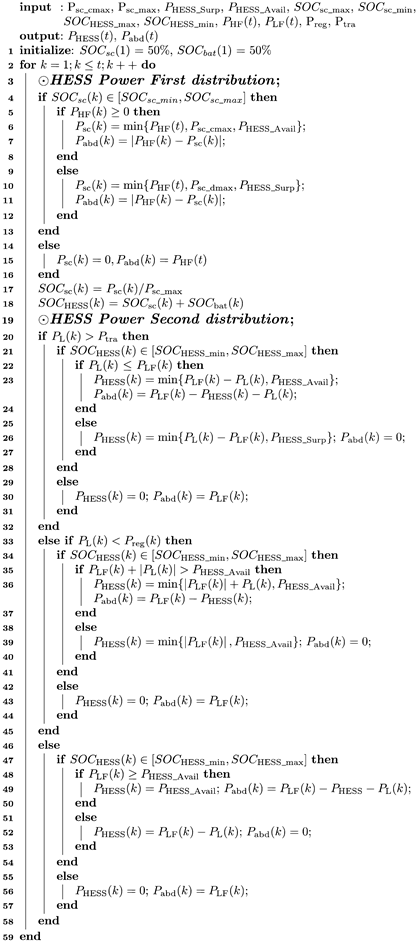 |
4. Results
4.1. Parameters
4.2. Case Study
5. Conclusions
Author Contributions
Funding
Institutional Review Board Statement
Informed Consent Statement
Data Availability Statement
Conflicts of Interest
References
- Zuo, J.; Dong, L.; Yang, F.; Guo, Z.; Wang, T.; Zuo, L. Energy Harvesting Solutions for Railway Transportation: A Comprehensive Review. Renew. Energy 2023, 202, 56–87. [Google Scholar] [CrossRef]
- Brenna, M.; Foiadelli, F.; Kaleybar, H.J. The Evolution of Railway Power Supply Systems Toward Smart Microgrids: The Concept of the Energy Hub and Integration of Distributed Energy Resources. IEEE Electrif. Mag. 2020, 8, 12–23. [Google Scholar] [CrossRef]
- Feng, C.; Gao, Z.; Sun, Y.; Chen, P. Electric Railway Smart Microgrid System with Integration of Multiple Energy Systems and Power-Quality Improvement. Electr. Power Syst. Res. 2021, 199, 107459. [Google Scholar] [CrossRef]
- D’Arco, S.; Piegari, L.; Tricoli, P. Comparative Analysis of Topologies to Integrate Photovoltaic Sources in the Feeder Stations of AC Railways. IEEE Trans. Transp. Electrif. 2018, 4, 951–960. [Google Scholar] [CrossRef]
- Zhu, X.; Hu, H.; Tao, H.; He, Z. Stability Analysis of PV Plant-Tied MVdc Railway Electrification System. IEEE Trans. Transp. Electrif. 2019, 5, 311–323. [Google Scholar] [CrossRef]
- Akbari, S.; Hashemi-Dezaki, H.; Fazel, S.S. Optimal Clustering-Based Operation of Smart Railway Stations Considering Uncertainties of Renewable Energy Sources and Regenerative Braking Energies. Electr. Power Syst. Res. 2022, 213, 108744. [Google Scholar] [CrossRef]
- Yuan, J.; Cheng, K.; Qu, K. Optimal Dispatching of High-Speed Railway Power System Based on Hybrid Energy Storage System. Energy Rep. 2022, 8, 433–442. [Google Scholar] [CrossRef]
- Lu, Q.; Gao, Z.; He, B.; Che, C.; Wang, C. Centralized-Decentralized Control for Regenerative Braking Energy Utilization and Power Quality Improvement in Modified AC-Fed Railways. Energies 2020, 13, 2582. [Google Scholar] [CrossRef]
- Khan, K.A.; Khalid, M. Improving the Transient Response of Hybrid Energy Storage System for Voltage Stability in DC Microgrids Using an Autonomous Control Strategy. IEEE Access 2021, 9, 10460–10472. [Google Scholar] [CrossRef]
- Yuan, J.; Peng, L.; Zhou, H.; Gan, D.; Qu, K. Recent Research Progress and Application of Energy Storage System in Electrified Railway. Electr. Power Syst. Res. 2024, 226, 109893. [Google Scholar] [CrossRef]
- Zhang, Y.; Diao, L.; Pei, H.; Wu, Q.; Zhang, J.; Du, H.; Xu, C. A Power-Speed Hierarchical Optimization Framework of Diesel/Battery/Supercapacitor Vehicular Hybrid Propulsion Systems. Ocean. Eng. 2023, 288 Pt 1, 116043. [Google Scholar] [CrossRef]
- Malozyomov, B.V.; Martyushev, N.V.; Kukartsev, V.A.; Kukartsev, V.V.; Tynchenko, S.V.; Klyuev, R.V.; Zagorodnii, N.A.; Tynchenko, Y.A. Study of Supercapacitors Built in the Start-Up System of the Main Diesel Locomotive. Energies 2023, 16, 3909. [Google Scholar] [CrossRef]
- Han, X.; Chen, F.; Cui, X.; Li, Y.; Li, X. A Power Smoothing Control Strategy and Optimized Allocation of Battery Capacity Based on Hybrid Storage Energy Technology. Energies 2012, 5, 1593–1612. [Google Scholar] [CrossRef]
- Li, X. Fuzzy Adaptive Kalman Filter for Wind Power Output Smoothing with Battery Energy Storage System. IET Renew. Power Gener. 2012, 6, 340–347. [Google Scholar] [CrossRef]
- Howlader, A.M.; Matayoshi, H.; Senjyu, T. A Robust H∞ Controller Based Gain-Scheduled Approach for the Power Smoothing of Wind Turbine Generator with a Battery Energy Storage System. Electr. Power Compon. Syst. 2015, 43, 2156–2167. [Google Scholar] [CrossRef]
- Li, Y. Research on Fusion Method of Nonlinear System. In Proceedings of the 2022 IEEE 6th Information Technology and Mechatronics Engineering Conference (ITOEC), Chongqing, China, 4–6 March 2022; pp. 261–264. [Google Scholar] [CrossRef]
- Ponomarev, A.V. Systems Analysis of Discrete Two-Dimensional Signal Processing in Fourier Bases. In Advances in Signal Processing, Intelligent Systems Reference Library; Springer: Cham, Switzerland, 2020; pp. 87–96. [Google Scholar]
- Khokhar, S.; Mohd Zin, A.A.; Memon, A.P.; Mokhtar, A.S. A New Optimal Feature Selection Algorithm for Classification of Power Quality Disturbances Using Discrete Wavelet Transform and Probabilistic Neural Network. Measurement 2017, 95, 246–259. [Google Scholar] [CrossRef]
- Huang, N.E.; Shen, Z.; Long, S.R.; Wu, M.C.; Shih, H.H.; Zheng, Q.; Yen, N.-C.; Tung, C.C.; Liu, H.H. The Empirical Mode Decomposition and the Hilbert Spectrum for Nonlinear and Non-Stationary Time Series Analysis. Proc. R. Soc. Lond. Ser. A Math. Phys. Eng. Sci. 1998, 454, 903–995. [Google Scholar] [CrossRef]
- Wu, Z.; Huang, N.E. Ensemble Empirical Mode Decomposition: A Noise-Assisted Data Analysis Method. Adv. Adapt. Data Anal. 2009, 1, 1–41. [Google Scholar] [CrossRef]
- Li, M.; Li, Y.; Choi, S.S. Dispatch Planning of a Wide-Area Wind Power-Energy Storage Scheme Based on Ensemble Empirical Mode Decomposition Technique. IEEE Trans. Sustain. Energy 2021, 12, 1275–1288. [Google Scholar] [CrossRef]
- Liang, T.; Xie, G.; Fan, S.; Meng, Z. A Combined Model Based on CEEMDAN, Permutation Entropy, Gated Recurrent Unit Network, and an Improved Bat Algorithm for Wind Speed Forecasting. IEEE Access 2020, 8, 165612–165630. [Google Scholar] [CrossRef]
- Jia, Y.; Li, G.; Dong, X.; He, K. A Novel Denoising Method for Vibration Signal of Hob Spindle Based on EEMD and Grey Theory. Measurement 2021, 169, 108490. [Google Scholar] [CrossRef]
- Liu, P.; Lai, J.; Chen, T.; Zeng, X.; Cheng, Y. Coordination Control Strategy of Co-Phase Traction Power Supply System Integrated with Hybrid Energy Storage Systems. In Proceedings of the 2022 5th International Conference on Energy, Electrical and Power Engineering (CEEPE), Chongqing, China, 22–24 April 2022. [Google Scholar]
- Zhao, S.; Feng, Q.; Yang, H.; Zhang, Y. Control Strategy of Hybrid Energy Storage in Regenerative Braking Energy of High-Speed Railway. Energy Rep. 2022, 8, 1330–1338. [Google Scholar] [CrossRef]
- Li, X.; Zhu, C.; Liu, Y. Traction Power Supply System of China High-Speed Railway under Low-Carbon Target: Form Evolution and Operation Control. Electr. Power Syst. Res. 2023, 223, 109682. [Google Scholar] [CrossRef]
- Ma, F.; Luo, A.; Xu, X.; Xiao, H.; Wu, C.; Wang, W. A Simplified Power Conditioner Based on Half-Bridge Converter for High-Speed Railway System. IEEE Trans. Ind. Electron. 2013, 60, 728–738. [Google Scholar] [CrossRef]
- Salkuti, S.R. Optimal Operation of Electrified Railways with Renewable Sources and Storage. J. Electr. Eng. Technol. 2021, 9, 239–248. [Google Scholar] [CrossRef]
- Liu, S.; Yan, J.; Yan, Y.; Zhang, H.; Zhang, J.; Liu, Y.; Han, S. Joint operation of mobile battery, power system, and transportation system for improving the renewable energy penetration rate. Appl. Energy 2024, 357, 122455. [Google Scholar] [CrossRef]
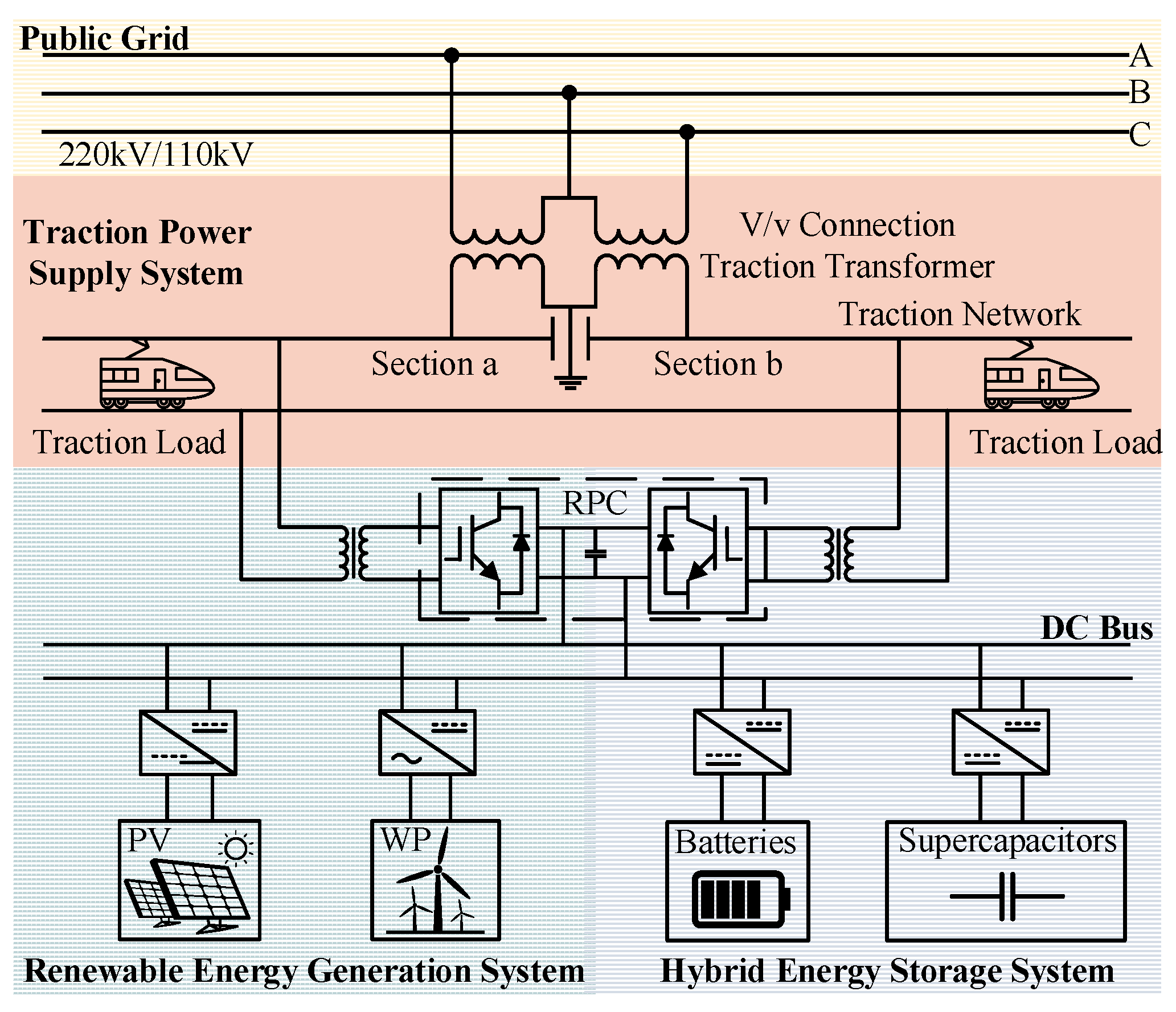
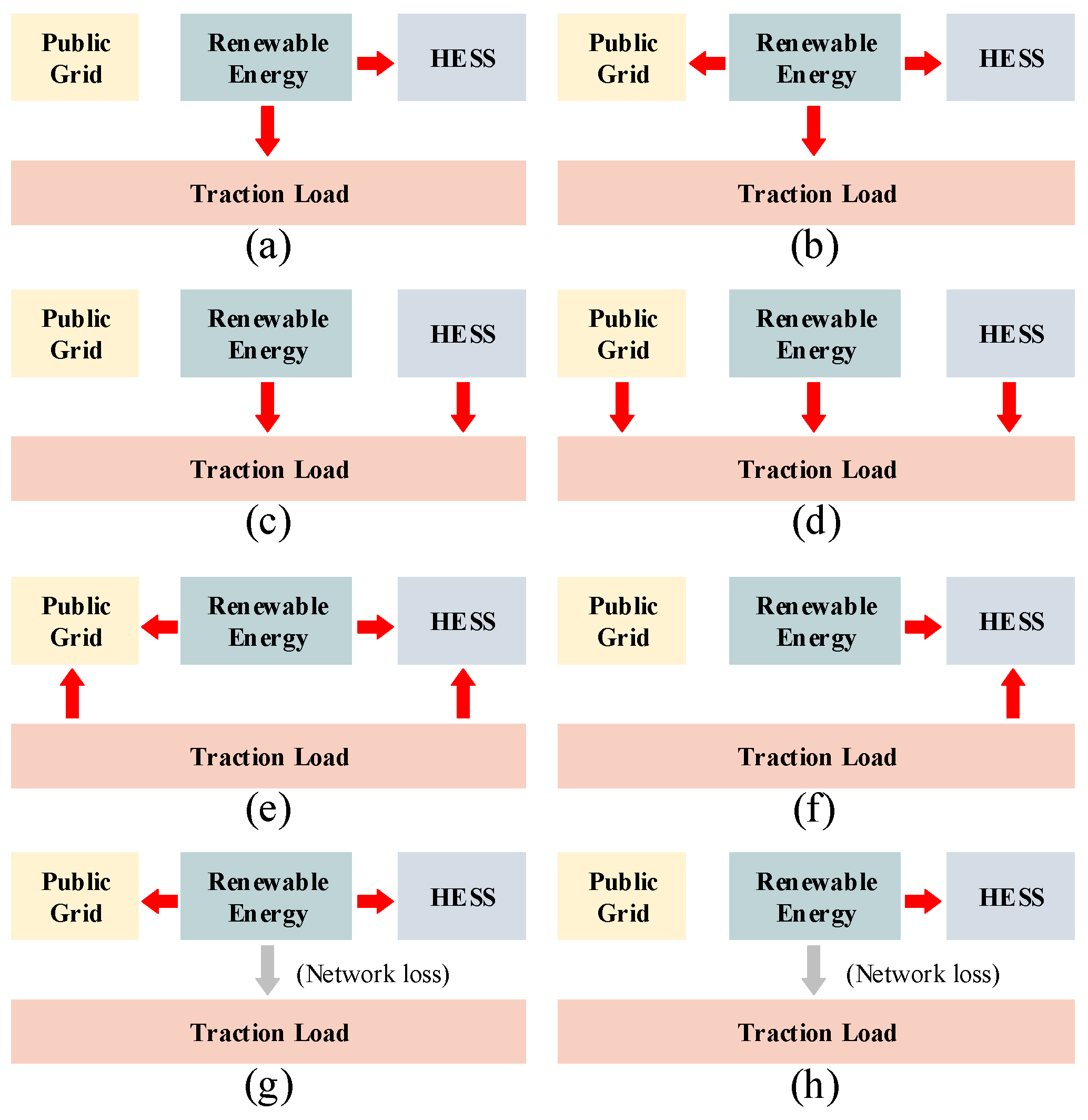
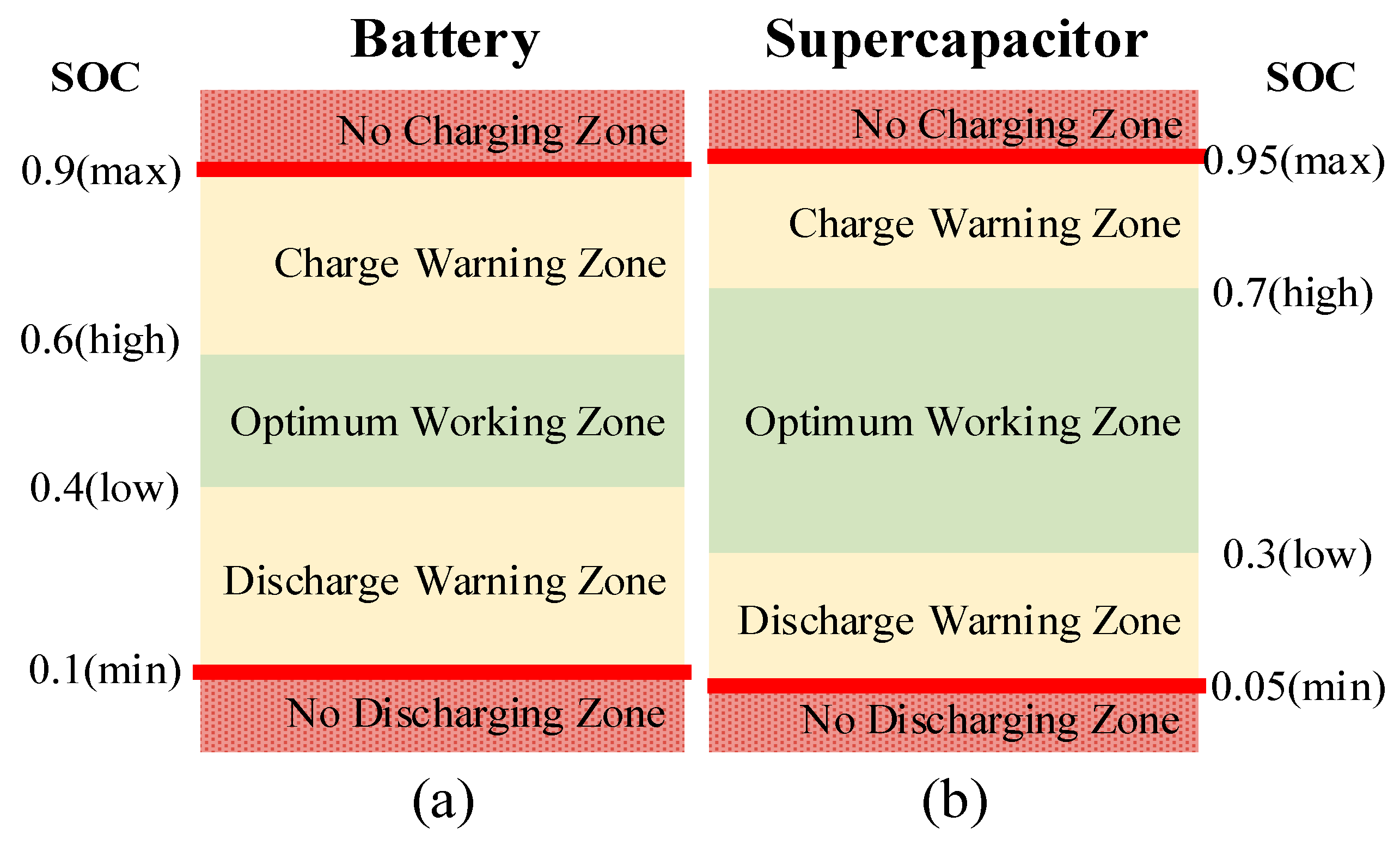
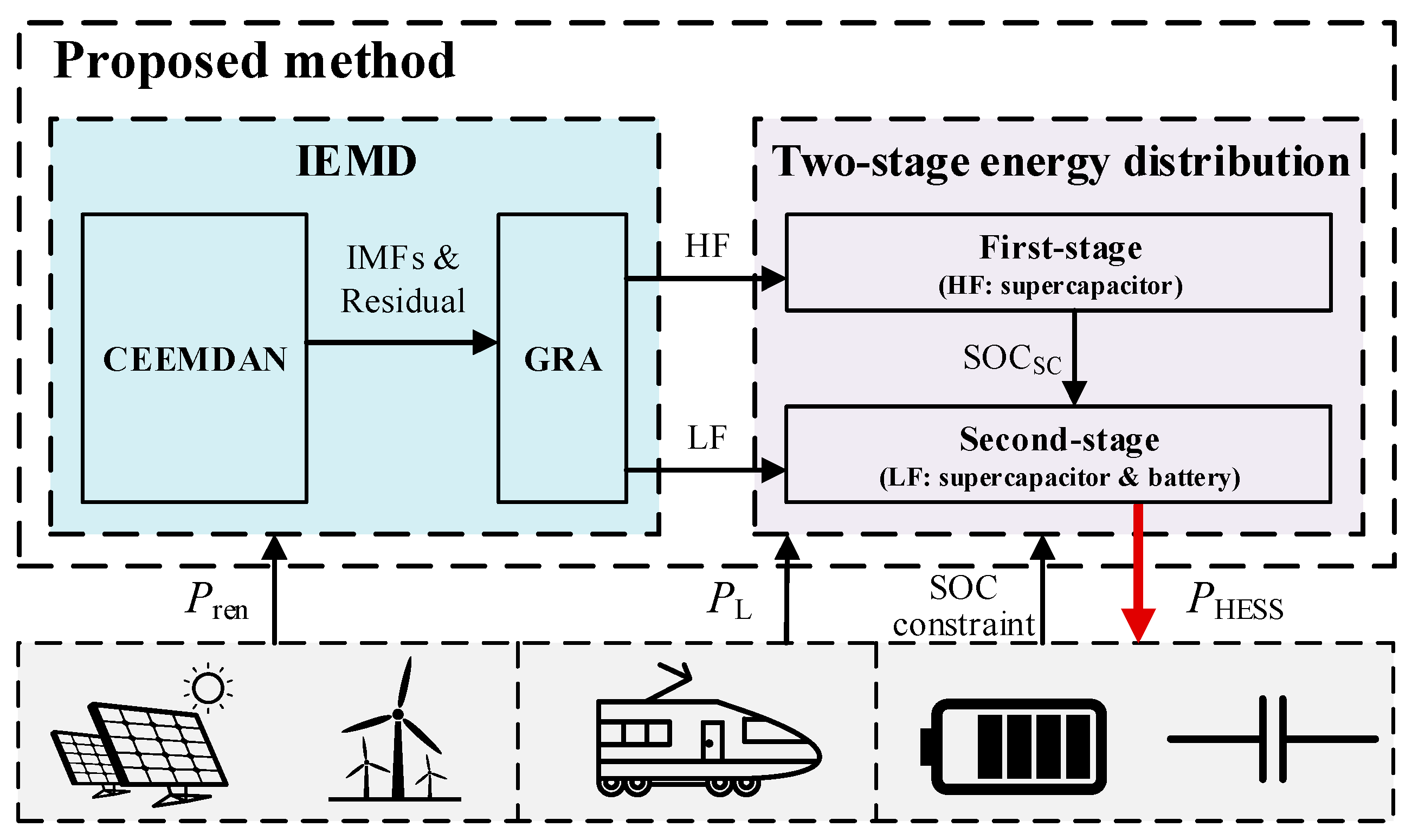

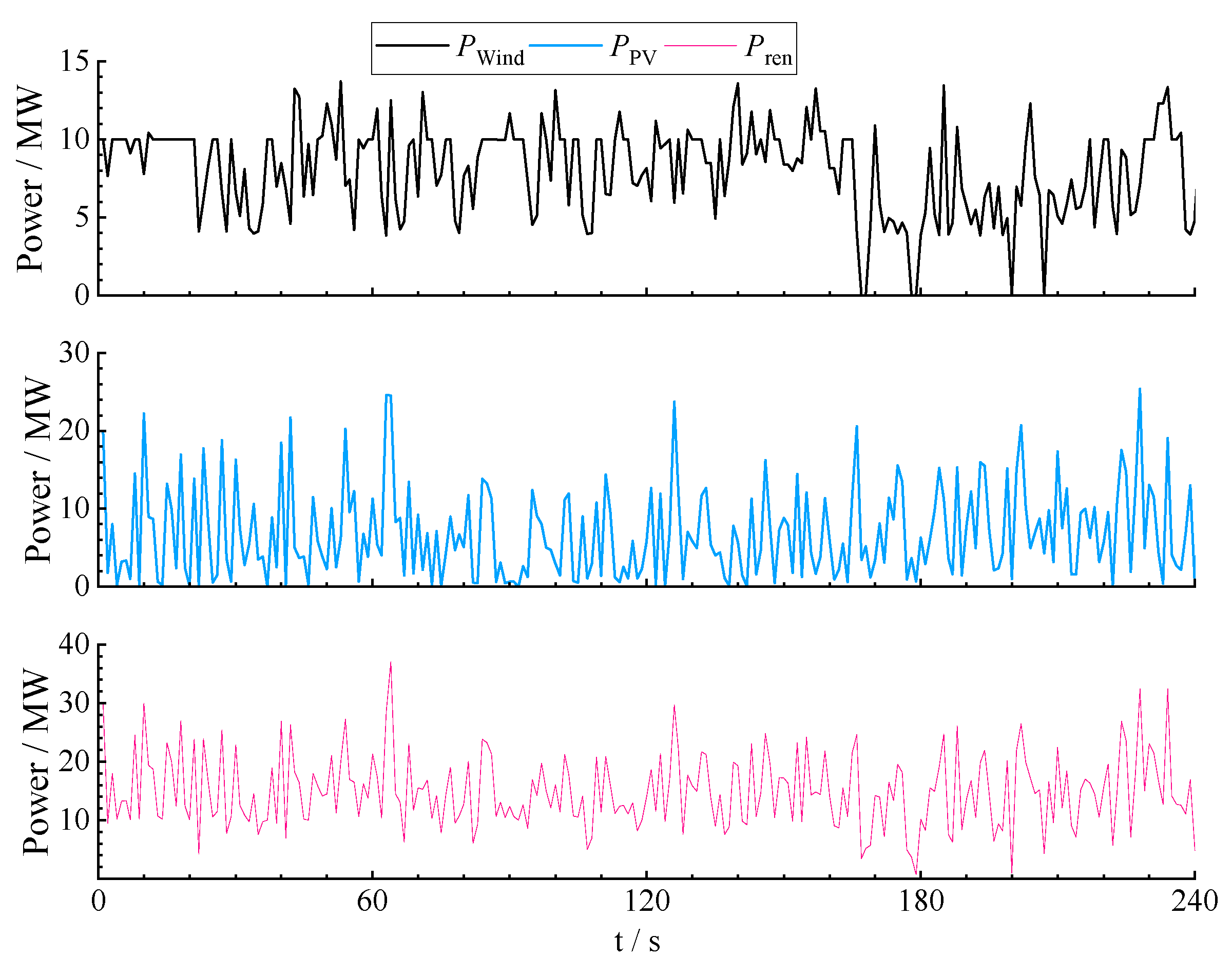
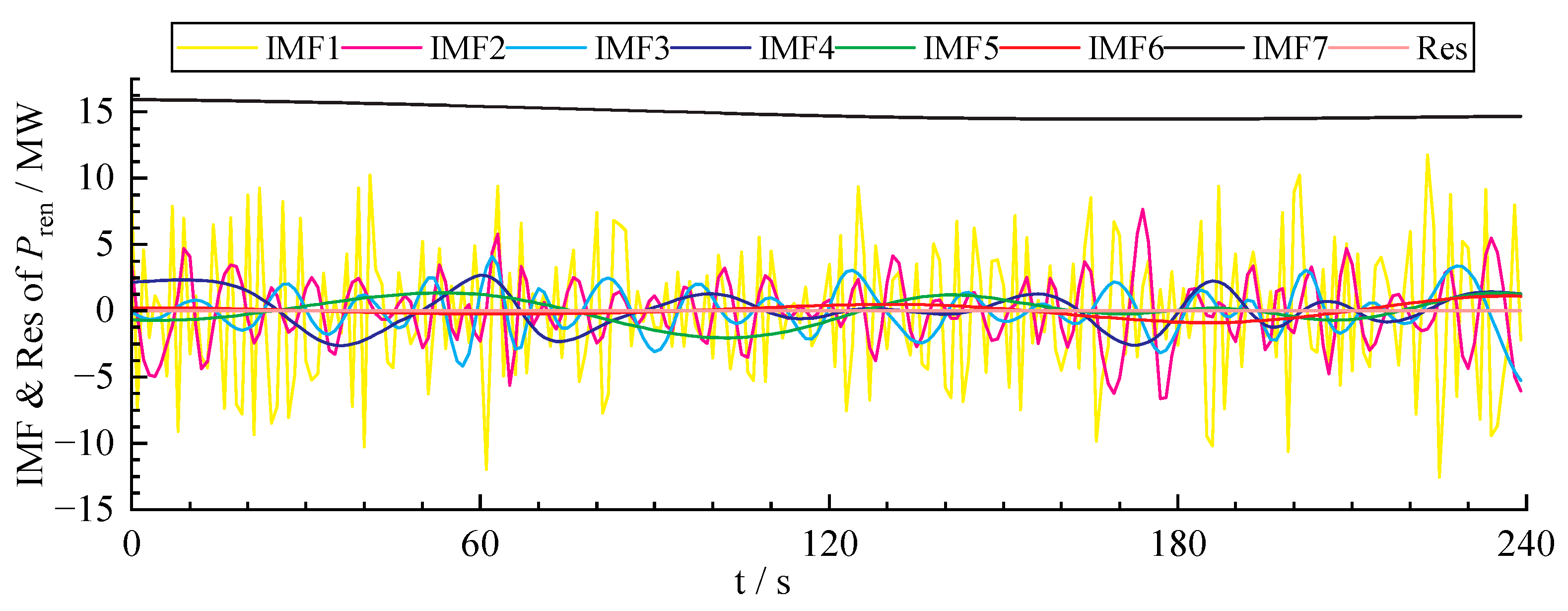
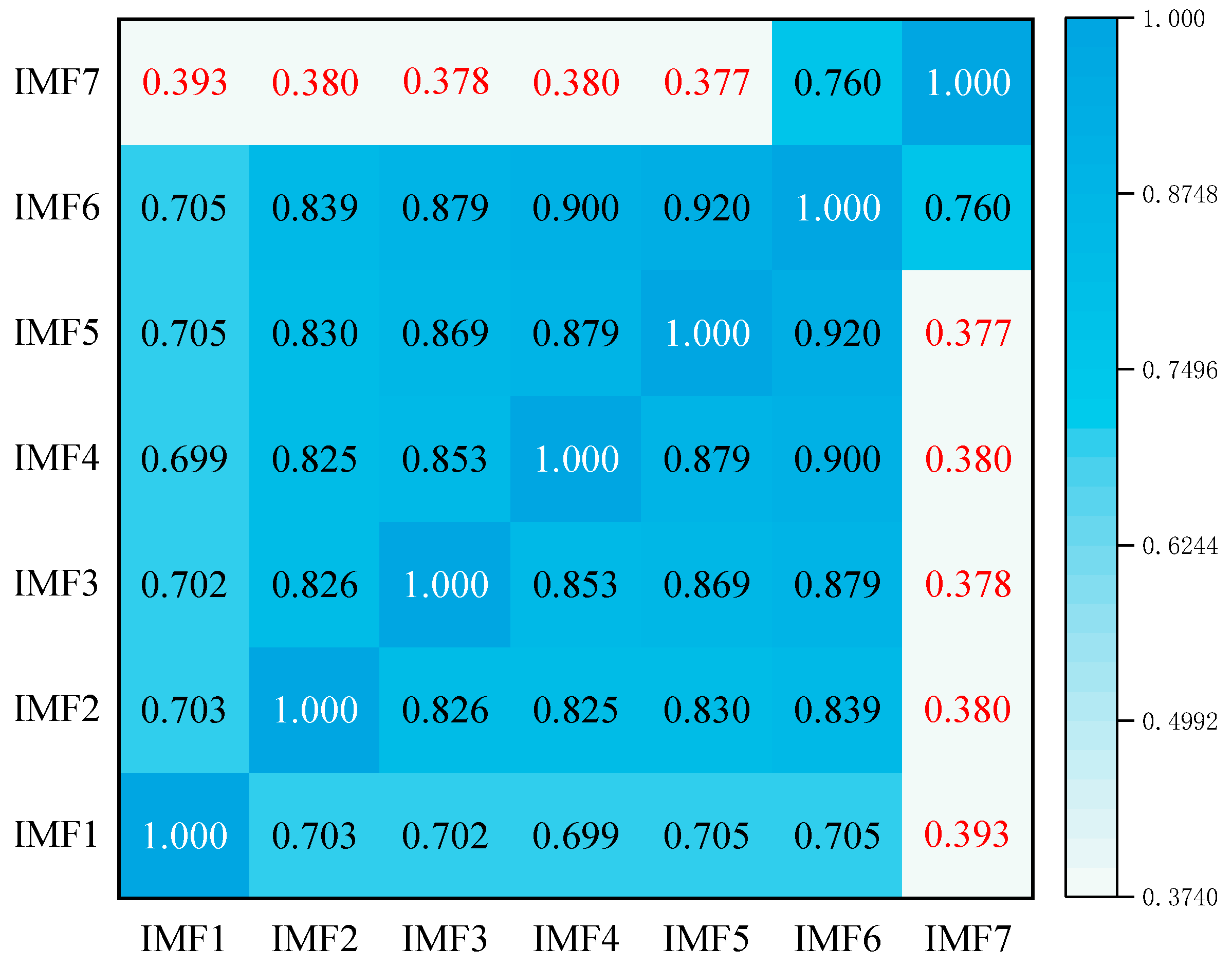
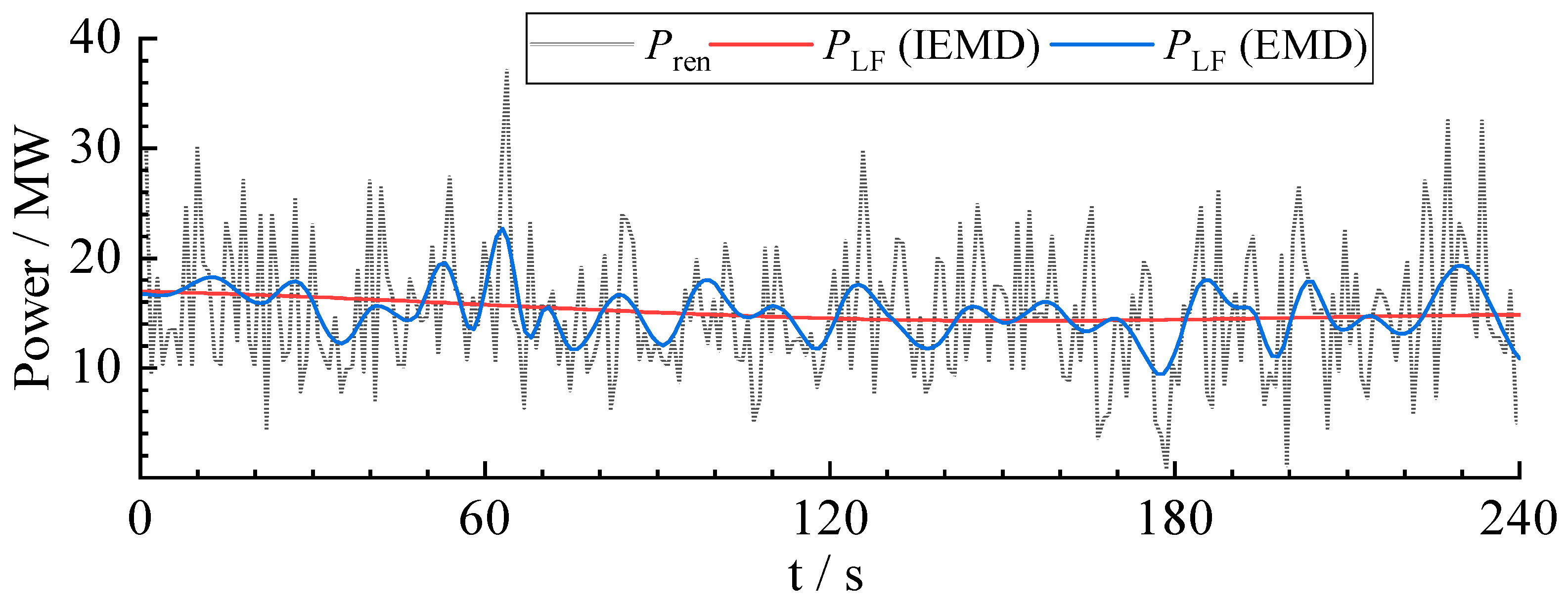
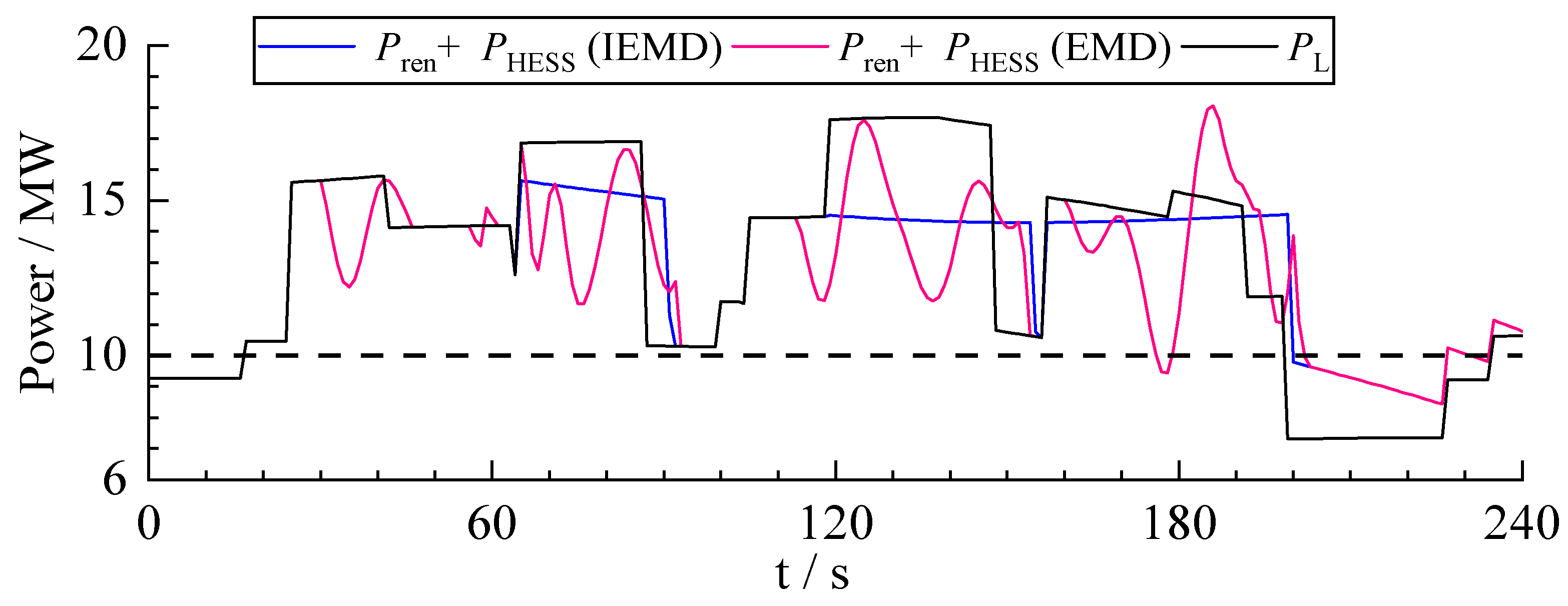
| Parameter Name | Battery | Supercapacitor |
|---|---|---|
| Rated capacity (kW) | 20,000 | 10,000 |
| Maximum charging power (kW) | 11,000 | 8500 |
| Maximum discharging power (kW) | 10,500 | 8500 |
| Charging efficiency (%) | 90 | 95 |
| Discharging efficiency (%) | 90 | 95 |
| Maximum SOC (%) | 90 | 95 |
| Minimum SOC (%) | 10 | 5 |
| Current SOC (%) | 50 | 80 |
Disclaimer/Publisher’s Note: The statements, opinions and data contained in all publications are solely those of the individual author(s) and contributor(s) and not of MDPI and/or the editor(s). MDPI and/or the editor(s) disclaim responsibility for any injury to people or property resulting from any ideas, methods, instructions or products referred to in the content. |
© 2024 by the authors. Licensee MDPI, Basel, Switzerland. This article is an open access article distributed under the terms and conditions of the Creative Commons Attribution (CC BY) license (https://creativecommons.org/licenses/by/4.0/).
Share and Cite
Ye, J.; Sun, M.; Song, K. An Energy Management Strategy for an Electrified Railway Smart Microgrid System Based on Integrated Empirical Mode Decomposition. Energies 2024, 17, 268. https://doi.org/10.3390/en17010268
Ye J, Sun M, Song K. An Energy Management Strategy for an Electrified Railway Smart Microgrid System Based on Integrated Empirical Mode Decomposition. Energies. 2024; 17(1):268. https://doi.org/10.3390/en17010268
Chicago/Turabian StyleYe, Jingjing, Minghao Sun, and Kejian Song. 2024. "An Energy Management Strategy for an Electrified Railway Smart Microgrid System Based on Integrated Empirical Mode Decomposition" Energies 17, no. 1: 268. https://doi.org/10.3390/en17010268
APA StyleYe, J., Sun, M., & Song, K. (2024). An Energy Management Strategy for an Electrified Railway Smart Microgrid System Based on Integrated Empirical Mode Decomposition. Energies, 17(1), 268. https://doi.org/10.3390/en17010268






